NVIDIA GeForce GTS 450 Launch Roundup: Asus, EVGA, Palit, and Calibre Overclocked and Reviewed
by Ryan Smith on September 13, 2010 6:08 PM ESTOverclocked Performance
The GTS 450 is already supported by the latest version of MSI’s excellent afterburner software, and keeping with their policy MSI has enabled overvoltage support for all cards using the same VRMs as the reference card. So we were able to overvolt all of our vendor cards, even those that do not officially support voltage control. The VRMs on all of the cards except the Asus card top out at 1.162v, however for safety reasons (and the fact that except on the Asus card the VRMs aren’t even passively cooled) we limited ourselves to 1.15v.
As not all of our cards are exactly alike, we’ll quickly run down the differences between the various cards
| Overclocking Results | ||||||
| Stock Clock | Max Overclock | Stock Voltage | Overclocked Voltage | |||
| GTS 450 Reference #1 | 783MHz | 955MHz | 1.05v | 1.115v | ||
| GTS 450 Reference #2 | 783MHz | 930MHz | 1.062v | 1.115v | ||
| Asus ENGTS450 Top | 925MHz | 985MHz | 1.125v | 1.115v | ||
| EVGA GTS 450 FTW | 920MHz | 955MHz | 1.112v | 1.115v | ||
| Palit GTS 450 Sonic Platinum | 930MHz | 985MHz | 1.087v | 1.115v | ||
| Sparkle Calibre X450G | 850MHz | 935MHz | 1.087v | 1.115v | ||
Out of the 4 cards in today’s roundup, we got fairly wide range of overclocking, with the top and bottom cards varying by 50MHz. The VID of the GPU had little impact on the final overclock, as we had a 1.087v card turn in the lowest overclock while a 1.125v card turned in the highest overclock. Excluding the Calibre card, the cards with the best cooling did get the best overclocks, but temperature doesn’t look to be a serious factor here as we’ve already seen that temperatures barely crack 70C. So the overclockability of any card (including these factory overclock cards) looks to be the luck of the draw, with the factory overclocked cards removing the chance of getting a dud GPU that won’t break 900MHz.
The Asus and the Palit cards maxed out at both the same core clock and the same memory clock – 985MHz and 1050MHz (4.2GHz effective) respectively, returning the same performance as a result. Elsewhere the EVGA card got the next best overclock, followed by the Calibre.

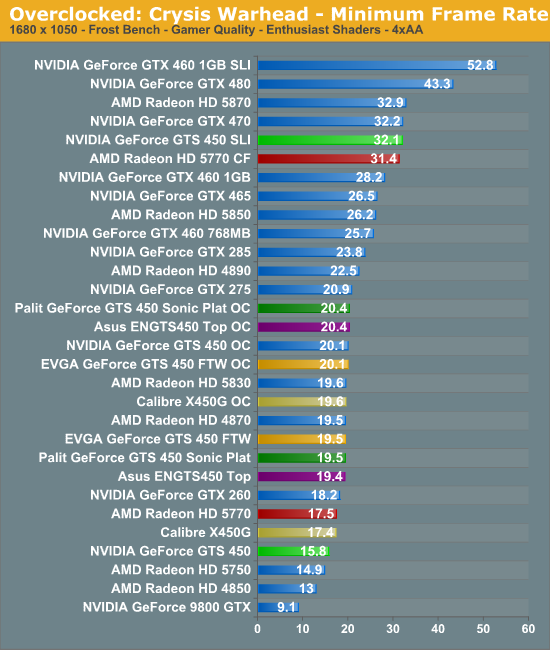
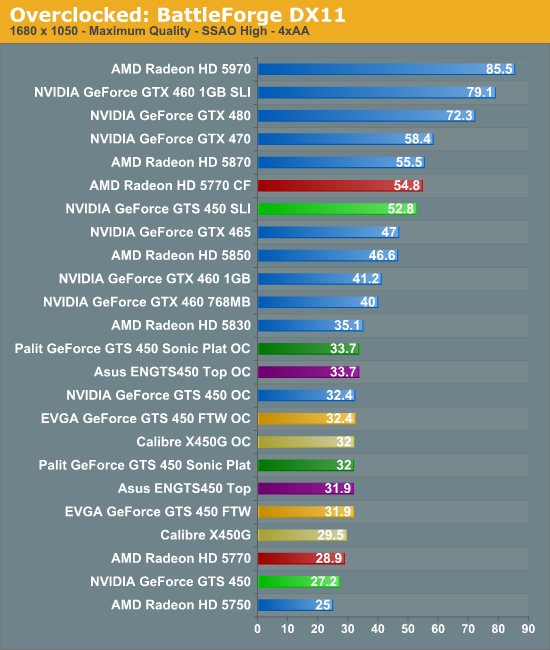
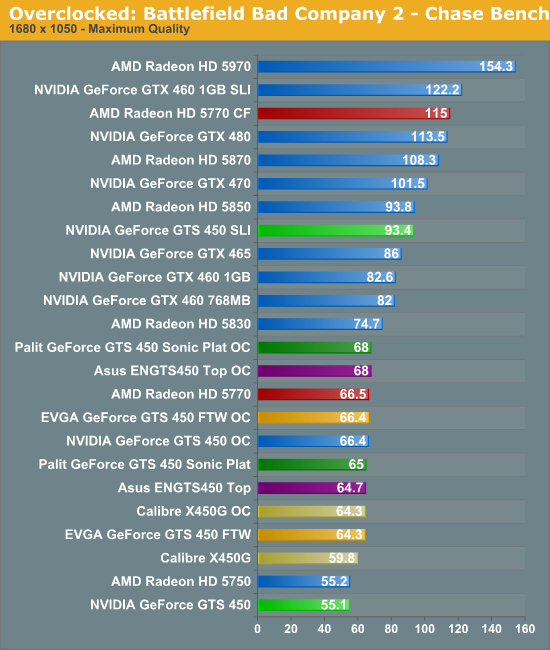
The results in our games follow the overclocks achieved, with the Palit and Asus cards topping the list, followed by the EVGA and Calibre cards. What’s immediately clear is that with already-hefty factory overclocks on the Asus, EVGA, and Palit cards, further overclocking isn’t nearly as productive. A 6% core overclock on the Asus card for example is good for around 5% more performance, but it doesn’t shift the results in any meaningful manner. Unless you could push one of these cards over 1GHz, further overclocking is more for show than it is to really improve performance.
The Calibre of course is the lone holdout from this statement. It may have had the lowest final overclock, but it also had the lowest factory overclock – we were able to give it another 10% on the core clock which allowed it to more or less close the performance gap between it and the other factory overclocked cards.
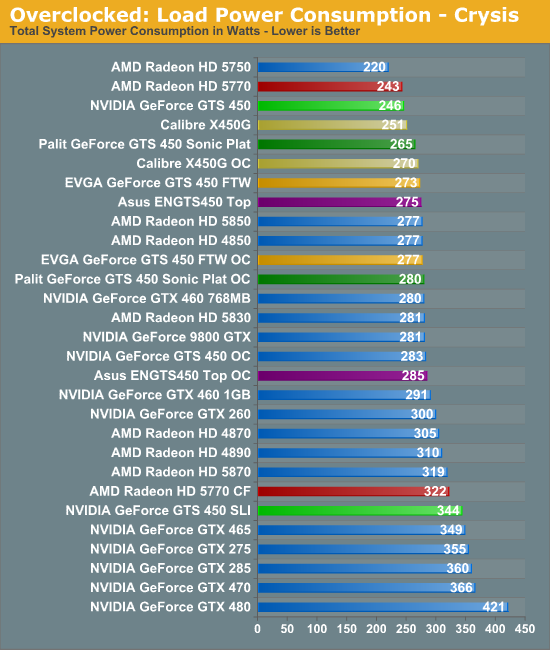
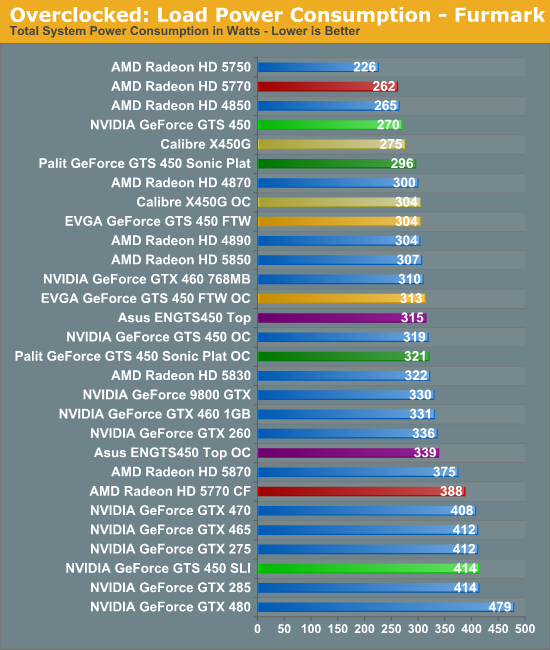
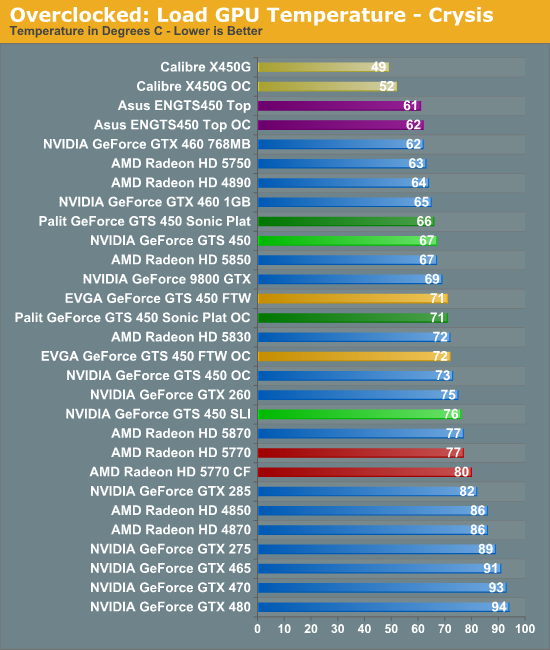
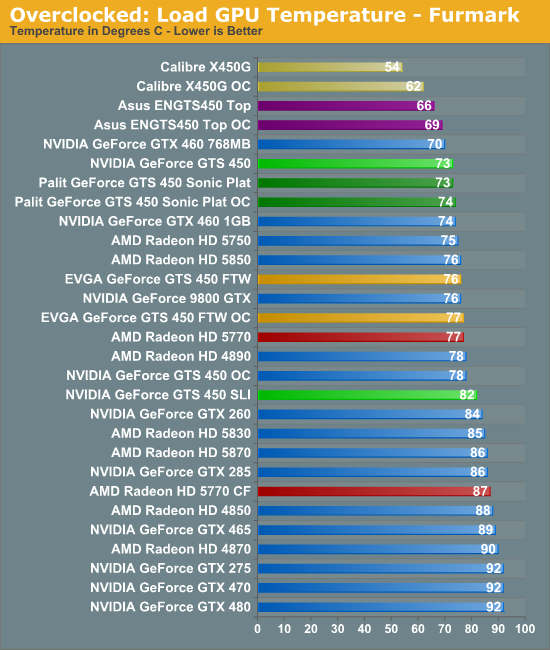

Since we went with 1.15v on all of our cards in order to try to find the highest reasonable overclock, all of these cards take a heavy hit when it comes to power, temperature, and noise. The Asus card does the worst here in terms of power thanks in a big part to its top overclock, followed by the Palit, EVGA, and Calibre cards. At this point we’re 30-40W over a reference GTS 450 in Crysis, and 35-70W in Furmark.
When it comes to temperatures, with the exception of the Calibre which jumps 8C, the extra voltage and overclocks has little impact on the GPU temperatures for our cards. The penalty is paid by the amount of noise generated, where all of these cards get 1-3dB(A) louder. Combined with the lackluster overclocking results, and this is probably a good reason to not bother with further overclocking except on the Calibre card.










16 Comments
View All Comments
gwolfman - Monday, September 13, 2010 - link
When do we get our first single slot Fermi? I'd like one to offload my PhysX. Any ideas?Slash3 - Monday, September 13, 2010 - link
Looks like an error on the first page's chart, the memory clock box for the reference card should be at a 3.6GHz data rate and not 4.6GHz, correct?anactoraaron - Monday, September 13, 2010 - link
And their responce to the bending issue is why they are just the best to work with (and buy from) for anything - including RMA's. They are first in that category (customer service) hands down. Over the course of 7 years, I have had to RMA something (at least one item) to ASUS, HIS (the worst by far), Gigabyte and EVGA. EVGA FTW!Voldenuit - Monday, September 13, 2010 - link
Warping, like all of life's problems, is just a special case of bending.Shadowmaster625 - Tuesday, September 14, 2010 - link
You guys should simulate 2-3 months of heavy dust collecting inside a PC case. Then run the furmark power consumption and heat tests. Then you might understand why people want a card like the Calibre X450G.HangFire - Thursday, September 16, 2010 - link
2-3 months does not make for heavy dust in any of my PC cases. 2-3 years would, but none run that long before getting cleaned out.The real market for the Calibre would be the silent PC crowd, who would otherwise pay extra for an Accelero (or other aftermarket GPU cooler), and would be happy to pay a smaller premium for a pre-installed cooler- and keep their warranty too.
tech6 - Tuesday, September 14, 2010 - link
Since you can get a 5770 from NewEgg for $125 (with rebate) and GTX460 for $170, I don't see why any of these cards make much sense unless they will be heavily discounted.JPForums - Tuesday, September 14, 2010 - link
<quote>Since you can get a 5770 from NewEgg for $125 (with rebate) and GTX460 for $170, I don't see why any of these cards make much sense unless they will be heavily discounted. </quote>At $130 straight up these GTS450s make plenty of sense (especially if you don't want to deal with the sometimes less than reliable rebate system). They may not be quite as good a value as a $125 HD5770, but they are still a good buy. (particularly if you require an nVidia card) Of course, a GTX460 will net you a healthy performance boost for an equally healthy price bump.
Spazweasel - Tuesday, September 14, 2010 - link
They still do. Look in the part number. If it ends in "AR" it's lifetime warranty, if it's "TR" the warrant is (I think) 2 years. The price difference is generally 10 to 20 dollars, depending upon the base price of the part.shin0bi272 - Tuesday, September 14, 2010 - link
Id rather have a gtx470 super overclock from gigabyte. yeah its twice the price but its more than twice the speed. The gigabyte 470 soc out performs a gtx480 but costs 100 bucks less. So why go out and have to buy 2 450's to get halfway decent performance when you could buy 1 470 and spend the same amount?http://www.newegg.com/Product/Product.aspx?Item=N8...